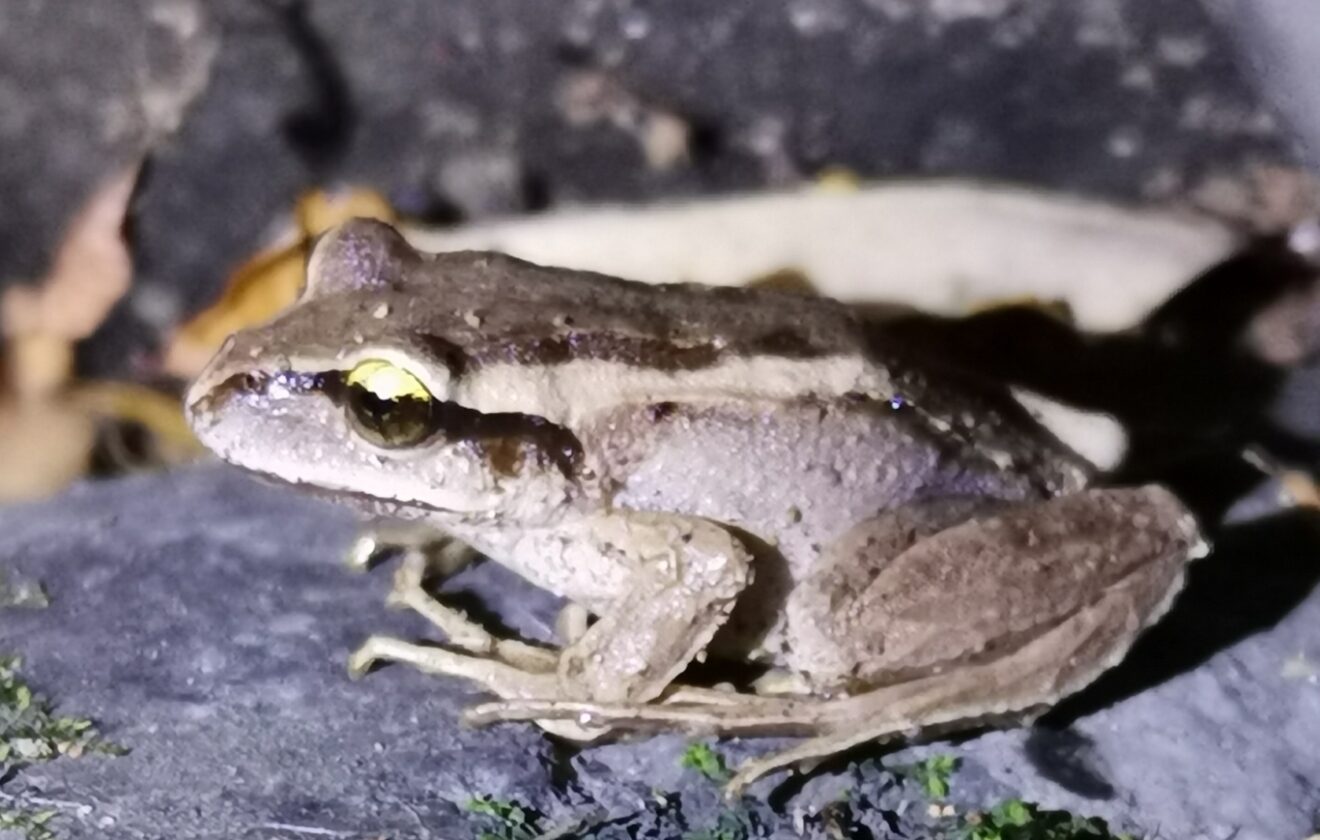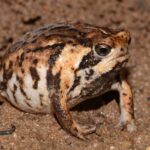- Batrachyla taeniata: Exploring the Secrets of Chile's Striped Wood Frog
- Introduction: A Quiet Guardian of Chile's Southern Forests
- Taxonomy and Classification: Unveiling the Family Tree of <em>Batrachyla taeniata</em>
- Natural Habitat: The Lush Sanctuaries of Chile's Temperate Rainforests
- Physical Characteristics: A Portrait of Quiet Elegance
- Behavior and Life Cycle: A Symphony of Natural Adaptation
- Ecological Role: Guardians of Forest Balance
- Threats and Conservation Status: Protecting Nature's Fragile Beauty
- Cultural and Scientific Significance: Silent Ambassadors of Biodiversity
- Conclusion: A Call to Action for the Striped Wood Frog
Batrachyla taeniata: Exploring the Secrets of Chile’s Striped Wood Frog#
Introduction: A Quiet Guardian of Chile’s Southern Forests#
In the damp tranquility of Chile’s temperate rainforests, beneath a verdant canopy resplendent in emerald hues, a small amphibian dwells quietly, hidden yet vitally important. The striped wood frog, scientifically named Batrachyla taeniata, epitomizes both subtle beauty and ecological significance in these precious southern habitats. At first glance, this tiny creature may evade the attention of casual observers. Yet drawing closer and observing carefully, one begins to appreciate why this delicate amphibian holds such fascination for scientists and nature lovers alike.
Belonging to the family Batrachylidae, Batrachyla taeniata earns its common name from the distinct stripes adorning its delicate body—a feature subtly celebrated through its formal Latin epithet “taeniata,” meaning banded or striped. Beyond mere aesthetics, however, lies an enchanting world of ecological interconnection, intriguing behaviors, and pressing conservation concerns. Few might guess that this modest amphibian represents not just a marvel of evolution, but also an essential piece of its habitat’s ecological fabric.
Taxonomy and Classification: Unveiling the Family Tree of Batrachyla taeniata#
The striped wood frog, Batrachyla taeniata, belongs to the broader order Anura—frogs and toads—and more specifically, the diminutive yet ecologically diverse frog family Batrachylidae. Within its genus Batrachyla, this species shares lineage with several other closely related species, collectively adapted to the cool, humid environments characteristic of Chile’s southern and central regions. Each species within this family shares distinctive characteristics, yet Batrachyla taeniata stands apart through its unique coloration patterns and specialized habitat preferences.
In scientific circles, accurate classification plays a crucial role, assisting conservationists and ecologists in identifying relationships among species, pinpointing specific evolutionary adaptations, and elucidating the historical biogeography that shaped today’s biodiversity. Thus, understanding the striped wood frog’s taxonomic roots is essential to grasp its ecological and evolutionary narrative fully.
Natural Habitat: The Lush Sanctuaries of Chile’s Temperate Rainforests#
Primarily found in southern Chile, particularly spanning from regions in the Maule area through Los Ríos and further south into Los Lagos, Batrachyla taeniata has adapted marvelously to the cool climates and steady precipitation characteristic of this region. Unlike many amphibians that prefer tropical warmth, this striped wood frog thrives amidst cool misty evenings and the damp woodland floor layers abundant with moss, leaf litter, and fallen logs.
Habitat Preferences and Adaptations#
The ideal habitat for Batrachyla taeniata is richly layered, combining moist understory vegetation, standing or slow-moving freshwater bodies, and shaded forest areas. These frogs are most commonly spotted near small ponds, streams, or temporary pools created by seasonal rains. These aquatic habitats are crucial breeding grounds, providing shelter for their delicate tadpoles to develop safely away from predation threats.
Uniquely, the species has a strong affinity for old-growth forests, where abundant decaying plant material creates humid microclimates vital for their delicate skin respiration. The damp, cooler environment helps them regulate their body temperature and moisture levels—an essential evolutionary adaptation allowing them to thrive amidst environmental challenges.
Physical Characteristics: A Portrait of Quiet Elegance#
Batrachyla taeniata is undeniably modest in size, typically measuring between just 25 and 35 millimeters in length from snout-to-vent. Its diminutive stature amplifies the beauty of its coloring—a refined contrast of earthy browns, subdued greens, and striking, darker longitudinal stripes along its flank. These stripes provide this species not just beauty but vital camouflage, rendering them almost invisible among fallen leaves, twigs, and the dappled shadows of forest floors.
Coloration, Camouflage, and Survival#
Their subtle earthy tones, reinforced by these banded patterns, serve as defensive adaptations, warding off predators by making the frogs practically indistinguishable from their surroundings. Evolution has thus finely crafted these delicate creatures to resemble the environment where they thrive deeply—a perfect embodiment of natural selection’s finesse.
Skin Texture and Adaptations#
Closely examining a striped wood frog reveals an intricate network of delicate skin adaptations. Moist, permeable, and smooth in texture, their skin aids critical processes such as water absorption, oxygen exchange, and even environmental toxin detection. Thus, healthy habitats free from harmful pollutants are crucial to these amphibians’ survival—making them valuable bioindicators for ecosystem health.
Behavior and Life Cycle: A Symphony of Natural Adaptation#
The seasonal rhythms of southern Chile profoundly influence the life and behaviors of Batrachyla taeniata. Primarily nocturnal and crepuscular, these secretive creatures delicately emerge from their refuges at dusk, venturing carefully into twilight to forage or seek mates. Their diet comprises primarily of insects—flies, mosquitoes, beetles—making them excellent natural pest controllers in their ecosystems.
Breeding Behavior: Voices in the Twilight#
Come the rainy season, usually spring to early summer, male frogs ambitiously announce their readiness to breed from the edges of shallow pools or damp corners sheltered by ferns and moss. Their natural chorus, gentle yet resonant, fills the quiet forest air, guiding females securely toward them. Fertilized eggs—delicate, gelatinous, jewel-like clusters—are laid in standing water hidden among foliage.
Tadpoles hatch from these intricate egg clutches, spending early developmental stages submerged and aided by slender tails and tiny gills. Over weeks to a few months, they transition remarkably, developing limbs, lungs, absorbing their tails, and finally venturing forth on land as fully formed juveniles ready to navigate life in forested habitats.
Ecological Role: Guardians of Forest Balance#
Although small and often overlooked, striped wood frogs significantly impact their habitats’ wellness and balance. As efficient insect predators, they help moderate insect populations, indirectly benefiting plant health and productivity. Simultaneously, frogs themselves serve as integral food sources for larger predators, including birds, reptiles, and mammals, showcasing their critical dual function woven into ecological food webs.
Furthermore, amphibians, especially species like Batrachyla taeniata, act as bioindicators, reflecting threats or declines within an ecosystem, thus providing an early signal to biologists and researchers deeply invested in the health and integrity of southern Chile’s precious forests.
Threats and Conservation Status: Protecting Nature’s Fragile Beauty#
Sadly, despite their significance, Batrachyla taeniata faces increasing conservation pressures. Habitat destruction, particularly deforestation for timber, farming expansions, and human encroachments, constitute primary threats, fragmenting delicate ecosystems effectively isolating populations, challenging their long-term genetic viability.
Climate change exacerbates these threats, altering rainfall patterns, prolonged dry periods, and shifting seasonal dynamics critical to their reproduction. According to the International Union for Conservation of Nature (IUCN), Batrachyla taeniata presently holds an assessment marking it as Near Threatened, underscoring the urgency of proactive conservation efforts.
Cultural and Scientific Significance: Silent Ambassadors of Biodiversity#
While direct cultural associations of the striped wood frog may be subtle, its scientific relevance looms large. Amphibians globally have proven critical in medical, toxicological, and climatic research. Understanding their adaptations and vulnerabilities provides clues for mitigating broader environmental crises and contributes novel biomedical insights with potential pharmacological utility.
Conclusion: A Call to Action for the Striped Wood Frog#
The story of Batrachyla taeniata offers much more than biology alone. It invites introspection about relationships people hold with their ecosystems and roles they could embrace as stewards of biodiversity. Ascending above straightforward observation, genuine concern for this tiny amphibian engenders authentic responsibility, evoking a meaningful call to action to preserve fragile ecosystems where nature’s smallest inhabitants quietly uphold balance, beauty, and biodiversity.











